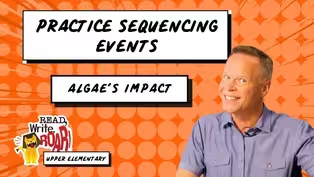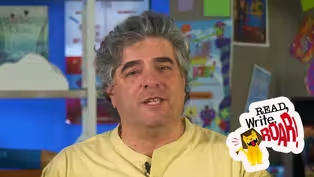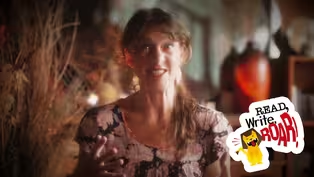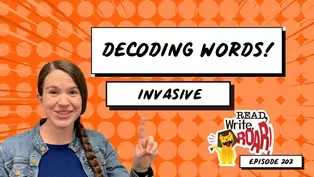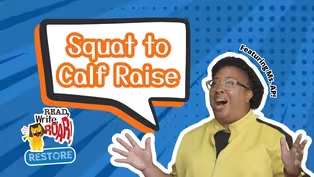Read, Write, ROAR!
Our Large Lakes
Season 1 Episode 1019 | 26m 45sVideo has Closed Captions
Learn how chemicals that make plants grow can cause problems like Algal Blooms on our Great La
On Read, Write, ROAR! Learn how chemicals that make plants grow can cause problems like Algal Blooms on our Great Lakes.
Problems playing video? | Closed Captioning Feedback
Problems playing video? | Closed Captioning Feedback
Read, Write, ROAR! is a local public television program presented by Detroit PBS
Read, Write, ROAR!
Our Large Lakes
Season 1 Episode 1019 | 26m 45sVideo has Closed Captions
On Read, Write, ROAR! Learn how chemicals that make plants grow can cause problems like Algal Blooms on our Great Lakes.
Problems playing video? | Closed Captioning Feedback
How to Watch Read, Write, ROAR!
Read, Write, ROAR! is available to stream on pbs.org and the free PBS App, available on iPhone, Apple TV, Android TV, Android smartphones, Amazon Fire TV, Amazon Fire Tablet, Roku, Samsung Smart TV, and Vizio.
Providing Support for PBS.org
Learn Moreabout PBS online sponsorship- On "Read, Write, ROAR!"
learn about how chemicals that make plants grow can cause problems from algal blooms on our Great Lakes.
- [Announcer] This program is made possible in part by the state of Michigan (bright rock music) and by viewers like you.
Thank you.
(bright rock music) - Did you know that a choice you make in your own backyard can have an effect on Lake Erie, a Great Lake that might be hundreds of miles away?
Hi, it's Mr. Peterson, and I'm wondering if you have ever heard of an organism or a living thing known as algae.
No?
Well, let's take a look at algae and learn about how some of the choices made by humans can make a big impact on our environment.
Algae is a plant-like organism that lives in water or moist areas and can perform photosynthesis, much like all the plants found on land, like flowers and trees.
Photosynthesis is the process of using sunlight to turn carbon dioxide from the air and water into food.
There are actually more than 70,000 different kinds of species of algae, and they can be very beneficial to our ecosystem but also can be very harmful.
While algae is plant-like in that it does use photosynthesis to make its food, it does not have the same structures as land plants, such as leaves or stems or roots.
There are some species of algae that are microscopic and can only be seen with a microscope.
While most algae is important to the food chain and the ecosystem that is a part of, there are some forms of algae that can be very harmful when they produce too much.
This happens every year in one of our Great Lakes.
Every summer in Lake Erie, there is a hazardous or dangerous algal bloom that threatens the lake and effects swimming at the beaches, quality of people's drinking water, and, unfortunately, kills thousands of fish.
What is the cause of this deadly algae bloom?
The answer may surprise you.
I asked my friend Anna from "Great Lakes Now" to tell us all about what algal blooms are and how they form.
I'm gonna take some notes based on what Anna tells us.
Then later, I'm going to use those notes to fill out a sequence chart.
- Hi there.
I'm Anna Sysling, host of "Great Lakes Now."
Hazardous algal blooms, also called HABs, are a threat to Lake Erie and many waterways.
They can make the lake toxic and impact our recreation, like swimming, along with our drinking water, and can negatively affect wildlife in and around the lake.
So what causes these algal blooms?
In the spring, farmers use fertilizer in their fields to help plants grow.
This fertilizer is food for the plants and contains nutrients like nitrogen and phosphorus.
When it rains, some of those nutrients from the fertilizer run off from the fields and enter the water system.
Once in the water system, the nutrients are carried downstreams into rivers, and eventually they make it into the lakes, lakes like Lake Erie, and even into the ocean.
A warm lake in the spring and summer full of nutrients is the perfect environment for algae to grow.
As the algae grows, it creates a thick green slime that covers the lake.
The slime grows so thick that sunlight can't reach the plants growing in the lake.
If the plants can't get sunlight, they can't use photosynthesis to make their food and they die.
Once the plants die, the animals that eat those plants no longer have food to eat, so they die too.
Some algae even produce a toxin that can harm or kill animals.
This process is called eutrophication.
So what can we do to help?
Reducing the pollution created by nutrient runoff from fertilizer is one great method of stopping the dangerous blooms.
- Thanks, Anna.
I learned so much about algae blooms in Lake Erie.
Okay, this is my sequence chart.
They don't have to look like this.
They can also just be a piece of paper with room to write.
A sequence chart helps us to look at the order in which things happen.
We start at the top, and we write the first thing that happens.
Then we go down the chart writing each thing that happens in order.
So what was the first thing Anna said about the cause of the algae bloom?
Oh, first, farmers use fertilizer on their fields to help their plants grow.
Then runoff from rain carries the nutrients in the fertilizer into Lake Erie water system.
The water's then carried through the streams and the rivers until it makes it to Lake Erie.
Alright, and after that, the warm summer water in the lake, oh, and the nutrients create the environment where algae grows rapidly.
So the algae then forms that green slime over the surface of the water.
Next, the sunlight is blocked by the green slime from reaching the plants in the lake.
The plants then die because they can't perform photosynthesis or make that food from the sunlight.
And then after that, unfortunately, the wildlife in the lake die because they can't eat the food or the plants.
Do you remember what Anna said the process was called?
It's a really big word, eutrophication.
Let's repeat that word, eutrophication.
Let's break the word down.
Eu is the prefix, which means well or good.
Ication is the suffix, meaning the process of becoming.
The middle part, troph, which means nourished.
Eutrophication, the process of something becoming well nourished.
In this case, a lake is becoming over nourished.
Let's write eutrophication at the top of the page for the heading of our sequence chart.
(bright rock music) This looks pretty good.
Look at everything that we've learned laid out in the correct order for us.
By looking closely at the order or sequence in which things happened, we can understand events and occurrences in the world better, and with knowledge comes power and responsibility.
Take a look at the sequence of events we talked about today.
How can you use the knowledge you gained in today's lesson to help impact our environment in a positive way?
(bright rock music) (bright rock music) - I'm Miss AP, here to help restore your energy, but before we begin, let's start our warmup.
Today we're gonna do five jumping jacks.
Ready, set, go.
One, two, three, four, five.
Nice job.
(air whooshing) Now that we've warmed up our body, we are ready to exercise.
Today we are going to expand on the squat movement we've learned.
Let's stand in the ready position with our feet apart and our hands at our sides.
Now we are standing tall and ready.
We'll move right into our squat movement, sitting down into your imaginary chair, hold and stand back up, straight and tall, and continue up on your tippy toes.
Lower your heels back down to the floor.
Let's try this together.
Standing in our ready position, sit down into your imaginary chair, hold, stand back up straight, up on your tippy toes, lower your heels back down to the floor.
Let's see how many we can do.
(bright rock music) Nice job.
Give yourselves a big clap clap.
(claps) Let's start our cool down.
Take two deep breaths in.
Breathe out, one, breathe in, breathe out, two, great job.
(bright rock music) (upbeat rock music) - Lake Superior is one of the biggest lakes in the world, but not many people know how many amazing stories it has.
Hey, I'm Alexis.
I'm visiting the Marquette Maritime Museum in Michigan's Upper Peninsula to learn all about Lake Superior.
I know that the lake is gigantic, but I wanted to learn more about why it's important and why there's a whole museum about it, and so far I've learned that even if you've never been to Lake Superior or even the Upper Peninsula, there's a good chance that this lake has made a difference in your life.
Let's head inside, and I'll show you what I mean.
It's worth taking a second to introduce you to the lake if you've never been here before.
This is a map of Lake Superior.
It's the biggest of the five Great Lakes, and it touches four main areas: the northern part of Michigan's Upper Peninsula, where we are now, plus parts of Wisconsin and Minnesota, along with the southern part of Ontario, Canada.
Lake Superior is also the deepest of the Great Lakes.
The deepest area is right around here, and it's more than 1,300 feet deep.
Picture the tallest tree you've ever seen.
No matter how tall it is, this part of the lake is deeper than that, and Lake Superior is so deep partly because of glaciers.
Glaciers are huge piles of ice.
They can be thousands of feet tall.
Today you mainly find glaciers near the North and South Poles, but about 15,000 years ago, these piles of ice stretched all the way into this part of the United States and covered up Michigan.
And glaciers can be heavy.
Like, think about how hard it is to pick up a big snowman in the winter.
And now imagine that snowman is as tall as a house with 500 floors.
That's not exactly how heavy the glaciers were, but it gives you the right idea.
And when these super heavy glaciers moved across Michigan all those years ago, that weight pushed down on the ground and scooped out big holes in the land.
Then those holes later filled with water and became the Great Lakes, including Lake Superior.
Today, Lake Superior is an amazing place to play, explore, sail boats, fish and more, but come on, check this out.
Because the lake is so big, it can turn into a dangerous place when a storm comes through.
The wind can create huge waves that make it unsafe for ships and the people on them.
Most of the time the ships make it to shore okay.
For example, the captains can look for lighthouses on the shore.
Lighthouses send out beams of light way into the distance using lenses like this one, and these flashing lights tell sailors where they are and help them avoid crashing into things like land or rocks hiding under the water.
But sometimes even lighthouses aren't enough.
Shipwreck experts think that about 550 ships have sunk on Lake Superior.
Sometimes these ships are overwhelmed by the huge waves.
The waves crash over the ship and push them underwater until they're flooded.
That might be what happened to this ship called the Henry B. Smith, which sank in 1913.
This is just a model for the record.
The real ship was much bigger.
In other cases, the weather can get so stormy or foggy that it's hard for ships to see where they're going, and they crash onto rocks or shallow areas, and sometimes these ships sink so fast that nobody knows what happened to them.
That's the story of a ship called the S.S. Edmund Fitzgerald, which sank in 1975.
The ship sank so quickly that none of the sailors were able to make it off the boat and tell anyone what happened.
Because of this mystery, the Edmund Fitzgerald is one of the most famous shipwrecks on all the Great Lakes, and the Marquette Maritime Museum has a whole exhibit about it.
For instance, this is a picture of the ship's captain, Captain McSorley, and over here you can see what the pieces of the ship look like today on the bottom of the lake.
On most days though, Lake Superior is not a scary place at all.
A lot of people in this part of the Upper Peninsula spend a lot of their lives near the lake, doing things like swimming, playing on the beach, and fishing.
The lake has even become part of their identities.
Lake Superior is special, and living near the lake feels like part of who they are as people, the same way that being a baseball player, an artist, or a student might be part of who you are as a person.
So you see why Lake Superior is so easy to get excited about.
It's beautiful and so fun to visit, but it's also played a big part in the lives of millions of people.
Without it, cities like Marquette probably wouldn't exist.
And after learning about all of this, I now understand why there is an entire maritime museum here in Marquette.
There are enough stories to fill an entire building.
So thanks for joining me.
I'm glad you came.
(bright rock music) - Did you know there are thousands of sunken ships at the bottom of the Great Lakes?
And many shipwrecks haven't even been discovered yet.
I don't know about you, but I'm fascinated by shipwrecks.
Sometimes I wonder who was on the boat that went down into the watery depths.
Did anybody survive?
What caused the wreck?
Was there bad weather or just bad luck?
What was the boat carrying when it sank?
Where was it headed?
Every shipwreck has a story, a story that's often lost when a boat lies at the bottom of a lake or ocean, and year after year it slowly decays until someday, it's as though it was never even there.
But what if a shipwreck could talk?
What kind of story would it tell?
Hi everyone, I'm Jeff Kass, and today we're gonna talk about a kind of writing technique called personification.
Personification is when you take an inanimate object or a thing that can't move or talk or think on its own and you use your imagination to give it human qualities.
You make it move or talk or think.
For example, if I say, "My living room couch looks very welcoming this afternoon, like it really wants me to lie down on it and take a nap," I'm giving the couch the human emotions of being welcoming and of having a desire for me to nap on it.
But my couch is really just a bunch of pieces of wood screwed together, with some fabric and stuffing sewn on top of it.
It can't actually feel any certain way.
You can also use personification with ideas like freedom or weather events like a hurricane or wind or something else that occurs in nature, like a tree or a mountain.
But for today, let's just stick with objects.
Specifically, let's stick with shipwrecks.
Let's imagine that a shipwreck that's been lying at the bottom of Lake Michigan for a long time can actually talk and wants to tell us all about its experiences, like what it was doing on the water in the first place, what it imagines its purpose was, how it crashed, and what it feels like to be down at the bottom of the lake just rotting away or waiting to be discovered.
We'll need to imagine what a shipwreck might be thinking or feeling, but we don't have to just use our imagination.
We can do some research about shipwrecks in Lake Michigan and use our imagination based on what's known about them.
For instance, I recently heard about a shipwreck in Michigan called the Henry Clay.
That name sounded familiar to me, like I kinda remembered it from history class in high school a long time ago.
I was curious and did some more research about Henry Clay and found out he was a pretty important person in early American history.
That's why a boat was named after him.
Using what I learned, I wrote a poem personifying the Henry Clay shipwreck and telling what I imagine is its story, "The Henry Clay."
"In baseball, everybody knows three strikes means you're out, but what if you were born before baseball?
I mean, I was born in 1777, when the United States was still a baby, less than a year old, didn't even know how to crawl yet.
I grew up to be a senator from the great state of Kentucky and was the Speaker of the House, only the seventh one in history, when I helped end the War of 1812.
Later I became our nation's ninth Secretary of State.
I brought people together.
I made deals.
I was a big deal.
They called me The Great Compromiser.
I ran for president in 1824.
I lost.
Strike one.
I ran for president again in 1832.
Lost again.
Strike two.
I ran a third time in 1844.
Same result.
Strike three.
What do you call a three time loser, a Great Compromiser nobody wanted?
At least somebody named a boat after me.
At least somebody believed I could brave the frigid waves of Lake Michigan even during the cold month of December in the cold year of 1850.
Unfortunately, my skill of getting people to compromise did not help when the towering swell overwhelmed my deck and leak sprang in my hull.
Maybe the compromise was that my crew survived, but they were lucky when the Troy stopped by on its way from Chicago to Detroit to save them.
Maybe that's the ultimate compromise.
They go home to their families, lived to board a different boat and another journey, and I stay here stuck in the cold, lonely dark."
Here are some pointers to help you begin your research.
Start with a question.
Think about what you wanna know, like what happened to the ship?
Where was it found?
You may not find answers to all your questions, and that's okay.
Asking questions will help you focus on what's most important about the shipwreck story and guide you to interesting information.
Use different sources.
Use websites, videos, magazines.
Ask your teacher or a librarian for suggestions for trusted sources.
Take notes.
Write down interesting facts that stand out to you.
No need to write everything, just the important parts.
Pay attention to descriptions.
Notice words that paint a picture of the ship.
Was the ship unusually large or small?
Did it have any special features or decorations?
Descriptions can help you imagine the ship and bring it to life in your home.
Now it's time for you to try.
Visit a website about shipwrecks and pick one that interests you.
Do some research and then write a poem in the voice of that shipwreck.
Be a boat.
Tell the story.
(upbeat rock music) - Hello, friends, I'm Miss Audra, and today we're going to think about the sounds that bugs make.
So think about all the different sounds that a bug or an insect might make.
Maybe it's a cricket in the corner of your house or the sound of a daddy long leg just so quietly creeping across a floor.
Or maybe it's a sound of cicadas, and it sounds like almost an alarm going off.
So think about all the different sounds, crickets and bumble bees.
Before we do that, let's take a deep breath, a cleansing breath together, and study our bodies.
Here we go together.
(inhales deeply) And hold.
And blow it out.
(exhales deeply) And a breath in.
(inhales deeply) Hold and blow it out.
(exhales deeply) So remember, you're gonna make that sound, and you're gonna use a body movement.
So it could be your little fingers, it could be your hand, or your whole body if you have the room.
All right, on the count of three, one, two, three!
(gasps) That was it.
Make the sounds together.
Keep it going.
I'm gonna make my sound.
(Miss Audra faintly vocalizing) And on the count of three, we're gonna pause, one, two, three.
(inhales deeply) Nice.
Think about all the different sounds that you heard, the sounds that you made, the sounds that your neighbor made as we created our soundscape for insects today.
And before we say goodbye, let's take our breath.
Here we go, in.
(inhales deeply) Oh, and blow it out any way you want.
(imitates insects flying) Nice job.
Alright, we'll see you next time.
(upbeat rock music) - Do you ever find challenging words while you're reading?
I know I do.
I'm Mrs. Mora.
Today we'll learn to use word parts, like prefixes and suffixes, to read and understand unknown words.
Recently I've been reading about the Great Lakes, and I've come across some difficult words.
Here's a word.
First, let's circle the prefixes.
A prefix is a word part added to the beginning of a word to change its meaning.
Do you see a prefix?
It's I-N.
In.
Now let's circle the suffixes.
A suffix is a word part added to the end of a word to change its meaning.
Do you see a suffix?
It's I-V-E.
This final E does not make the I say its long sound, ahy.
Instead it says i, -ive.
Most English words do not end with V. When we hear v at the end of a word, we spell it with a final E, V-E. Next, let's mark the vowels in the root or base word.
Vowels help us break words into syllables.
Each syllable can have only one vowel sound.
Which vowels do you see?
We see A.
Since there is one vowel sound, we expect to find one syllable in this middle part.
Let's say the word parts.
In, vas, ive.
Now let's say the whole word, invasive.
Is that a real word?
Not quite.
Let's make it a real word.
I think we pronounced the prefix and suffix correctly.
So let's look at this middle part.
Let's try moving the S into this third syllable.
Then A might say ey instead of a.
Let's try.
Invasive.
Invasive, that's a real word.
Invasive is related to the word invade.
Invade has the prefix I-N, meaning in or into, and the Latin root V-A-D-E, meaning to go.
There are no suffixes.
Together, these word parts mean to go in or into.
Invasive also has the I-N prefix, meaning in or into.
The letters V-A-S come from the root V-A-D-E, meaning to go.
Then the I-V-E suffix changes the verb invade into an adjective, a describing word.
So invasive is an adjective describing something that goes in or into a place.
Invasive can describe a plant, animal, or disease that spreads quickly and harmfully.
In the Great Lakes, invasive fish threaten the population of native fish like lake trout and lake sturgeon.
If you speak Spanish, words like invasivo or invasor can help you understand this word.
(Mrs. Mora speaking Spanish) Great work today.
Keep reading and try the strategy the next time you find a challenging word.
- [Announcer] This program is made possible in part by the state of Michigan (bright rock music) and by viewers like you.
Thank you.
(upbeat rock music) (pleasant tones resonating)
Bloom Boom: Algae Impact | Sequencing for Grades 4-5
Video has Closed Captions
Clip: S1 Ep1019 | 6m 45s | Dive into the world of algae and explore how human actions cause harmful algal blooms. (6m 45s)
Bring Shipwrecks to Life with Poetry | Jeff Kass | Read, Write, ROAR!
Video has Closed Captions
Clip: S1 Ep1019 | 6m 25s | Bring a shipwreck’s story to life with poet and educator Jeff Kass. (6m 25s)
Create a Bug Soundscape | Ms. Audra | Read, Write, ROAR!
Video has Closed Captions
Clip: S1 Ep1019 | 2m 21s | Explore the sounds of crickets, cicadas, and other insects and mimic their movements. (2m 21s)
Decoding Words! INVASIVE | Prefixes, Suffixes, and Root Words for Multisyllabic Words
Video has Closed Captions
Clip: S1 Ep1019 | 4m 31s | Learn bow to use prefixes and suffixes to break big words down into understandable word parts. (4m 31s)
Read, Write, ROAR! Restore - Squat to Calf Raise
Video has Closed Captions
Clip: S1 Ep1019 | 2m 31s | Join Ms. AP in a quick 2-minute movement snack focused on jumping jacks to restore your energy. (2m 31s)
Providing Support for PBS.org
Learn Moreabout PBS online sponsorship

- Home and How To

Hit the road in a classic car for a tour through Great Britain with two antiques experts.












Support for PBS provided by:
Read, Write, ROAR! is a local public television program presented by Detroit PBS
